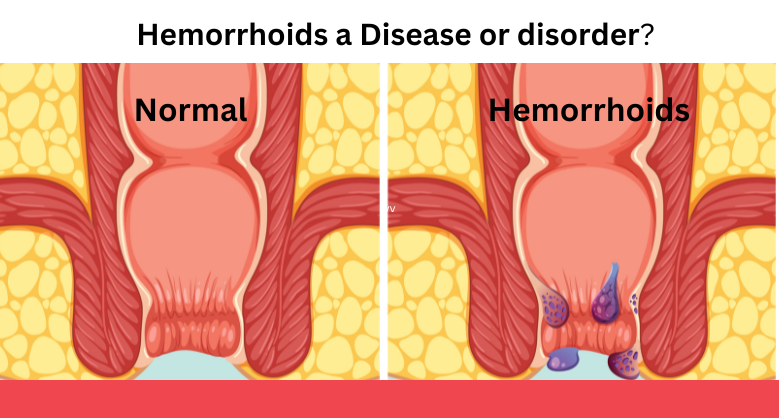By: medekomadmin
Hemorrhoids a Disease or disorder?
December 20, 2022

A hemorrhoid is a disease which is also called piles. In normal conditions, hemorrhoids act as cushions which help in stool movement. They became diseases when swollen, enlarged vascular structures called “hemorrhoids” refer to a disease seen in the anal canal of humans. There are two types of hemorrhoids one which develops inside the rectum and cause bleeding, itching is called internal hemorrhoids and the other with painful lumps around the anus called external hemorrhoids. About 75% of Indians are affected by piles due to a lack of seriousness. However, the exact cause of hemorrhoids is unknown. But some factors like diarrhoea, constipation,/ and sitting a long time in the toilet can cause hemorrhoids.
-
-
- Internal hemorrhoids
- There is painless bright red colour rectal bleeding during bowel movement.
- Pushing stool effectively, result in mucous discharge, perineal mass, itching and irritation.
- External hemorrhoids
- Itching or irritation around the anal region
- Painful bowel movement
- Swelling around the anus takes 2 to 3 days to disappear.
- Bleeding during bowel movement.
- Causes or Risk factorsSince the exact cause is known but there are some factors which can cause hemorrhoids which include -
- Irregular bowel either due to constipation or diarrhoea.
- Lack of exercise and low-fibre diets.
- Obesity
- Sitting in the toilets for a longer time.
- During pregnancy, baby weight puts pressure on the anal region.Having anal intercourse
- Regular heavy lifting
- Squatting while defecating
- Diagnosis :- If your bleeding continues for more than a week or experience pain during defecation then immediately consult to doctor. Hemorrhoids are typically diagnosed by physical examination by doctors.
- Digital rectal exam: Swollen veins can be felt by putting a gloved, lubricated finger into the rectum.
- Anoscopy-By using anoscopes serve as lighted tubes for viewing the rectum and anus linings. Internal hemorrhoids may require anoscopy.
- Internal hemorrhoids are generally classified into the first, second, third and fourth degrees.
- First-degree hemorrhoids do not protrude out of the anal canal.
- Second-degree hemorrhoids protrude with defecation.
- Third-degree hemorrhoids protrude and usually require manual replacement.
- Fourth-degree hemorrhoids protrude all the time and cannot be reduced manually.
- Sigmoidoscopy: The lower part (sigmoid) of the colon and rectum is viewed through a sigmoidoscope (lighted tube with a camera).
- There may be discomfort during these tests, but they are not painful. This process occurs under a doctor’s supervision. Though there is no need for anaesthesia outpatient persons may require anaesthesia.
- Prevention : For preventing hemorrhoids, one’s stool should be soft so that it can easily pass during defection. Following are the steps one should take care of at home –
- Eat high-fibre fruits and vegetables. Adding their items not only softens the stool but also helps us to avoid problems with gas.
- Drink plenty of water every day to keep your stools softens.
- Consider fibre supplements in your diet. Take 20-30 gm of fibre supplements per day in your diet. This will improve overall symptoms and bleeding from hemorrhoids.
- Try not to stain or hold your breath while defecting as it creates greater pressure in the lower rectum.
- As soon as you feel the urge go to the washroom. Do not wait for the stool to dry and become hard to pass.
- Exercise daily to stay active and lose weight which might help in controlling hemorrhoids.
- Avoid long periods of sitting.
- Treatments If the symptoms get worse or become more painful then go for treatment by your healthcare provider. Treatments which is provided by doctor are- Rubber band ligation: It is the first-line treatment for 1-to-3-degree internal hemorrhoids. A small elastic rubber band are applied around the base of the hemorrhoid to cuts off its blood supply to the vein. Its cure rate is a maximum of up to 87% with a complication rate of 3%.
- Electrocoagulation: The flow of blood to hemorrhoid stops by an electric current.
- Infrared coagulation: Heat is transmitted through a small probe inserted into the rectum to eliminate hemorrhoids.
- Sclerotherapy: A chemical such as phenol is injected into the swollen vascular structure to destroy hemorrhoid tissue.
- Surgical treatments – when other treatment fails then surgical treatment is done.
- Hemorrhoidectomy: Removing large external hemorrhoids or prolapsed internal ones surgically. Hemorrhoid stapling: A stapling instrument is used for removing the internal hemorrhoid followed by pulling of prolapsed hemorrhoid back inside the anus.
- Surgical treatments may include more complications like bleeding, infection, urinary retention etc but cure hemorrhoids. As we know “prevention is better than cure” so educating patients about changing their dietary habits and increasing their physical activity will help in preventing constipation.-Muskan jain
-